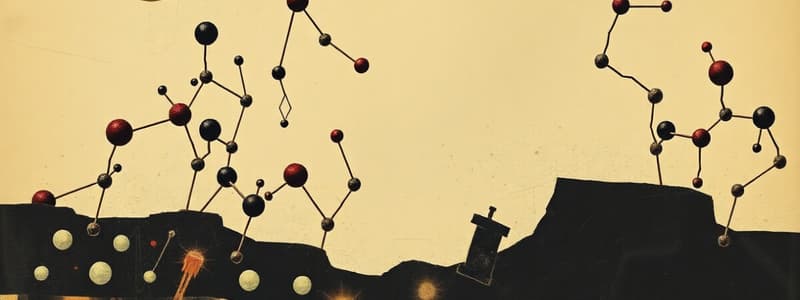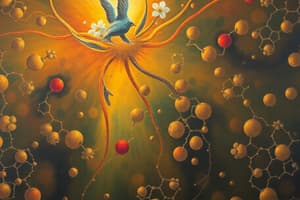Podcast
Questions and Answers
What is the primary function of triglycerides in biological systems?
What is the primary function of triglycerides in biological systems?
- Provide structural support to cells
- Transport hormones through the bloodstream
- Act as building blocks for sugars
- Serve as a storage form of energy (correct)
Which of the following best describes the role of phospholipids in cell membranes?
Which of the following best describes the role of phospholipids in cell membranes?
- They serve as electric insulators
- They form a bilayer that supports membrane structure (correct)
- They act as surfactants that aid in absorption
- They provide rigidity to the membrane
Which of the following is NOT a classification of lipids?
Which of the following is NOT a classification of lipids?
- Triglycerols
- Carbohydrates (correct)
- Phospholipids
- Sphingolipids
What is one of the primary functions of sphingolipids?
What is one of the primary functions of sphingolipids?
Which statement best describes fatty acids?
Which statement best describes fatty acids?
What process primarily involves the metabolism of lipids?
What process primarily involves the metabolism of lipids?
What is a key characteristic of complex lipids compared to simple lipids?
What is a key characteristic of complex lipids compared to simple lipids?
How do lipoproteins assist in the function of lipids?
How do lipoproteins assist in the function of lipids?
What two types of alcohol groups are found in the most abundant phosphoglycerides in higher plants and animals?
What two types of alcohol groups are found in the most abundant phosphoglycerides in higher plants and animals?
Which statement accurately describes sphingolipids?
Which statement accurately describes sphingolipids?
What is a key function of glycolipids in cell membranes?
What is a key function of glycolipids in cell membranes?
What are the three characteristic building block components of sphingolipids?
What are the three characteristic building block components of sphingolipids?
Which of the following substances is NOT classified as a phospholipid?
Which of the following substances is NOT classified as a phospholipid?
What is the structure of a triglyceride composed of?
What is the structure of a triglyceride composed of?
What primarily determines the state of triglycerides at room temperature?
What primarily determines the state of triglycerides at room temperature?
What role do phospholipids play in biological systems?
What role do phospholipids play in biological systems?
How does dietary cholesterol affect cholesterol synthesis in the body?
How does dietary cholesterol affect cholesterol synthesis in the body?
Which fatty acid class has its first double bond at carbon #3?
Which fatty acid class has its first double bond at carbon #3?
What is the primary site of cholesterol synthesis in the human body?
What is the primary site of cholesterol synthesis in the human body?
What type of lipoprotein carries cholesterol to the tissues?
What type of lipoprotein carries cholesterol to the tissues?
What characterizes omega-6 fatty acids?
What characterizes omega-6 fatty acids?
Which lipids are known to be the most abundant family of lipids?
Which lipids are known to be the most abundant family of lipids?
What is the function of high-density lipoprotein (HDL)?
What is the function of high-density lipoprotein (HDL)?
Which type of saturation is common in triglycerides that are liquid at room temperature?
Which type of saturation is common in triglycerides that are liquid at room temperature?
What is the effect of diets high in monounsaturated fats on LDL levels?
What is the effect of diets high in monounsaturated fats on LDL levels?
What component increases the complexity of plant and animal triglycerides?
What component increases the complexity of plant and animal triglycerides?
What is the primary function of lipase in lipid metabolism?
What is the primary function of lipase in lipid metabolism?
Flashcards are hidden until you start studying
Study Notes
Definition of Lipids
- Lipids are water-insoluble organic biomolecules composed of carbon, hydrogen, and oxygen (some contain phosphorus).
- They can be extracted from cells and tissues using non-polar solvents such as chloroform, benzene, or ether.
Function of Lipids
- Act as a storage form of energy.
- Serve as structural components of cell membranes.
- Precursors for many steroid hormones, vitamin D, and bile acids.
- Act as thermal insulators, protecting internal organs.
- Improve the absorption of fat-soluble vitamins.
- Act as surfactants by reducing surface tension.
- Improve taste and palatability.
- Act as electric insulators in neurons.
Classification of Lipids
- Simple Lipids:
- Fatty acids
- Steroids (e.g., cholesterol)
- Triglycerols
- Complex Lipids:
- Phospholipids
- Glycolipids
- Sphingolipids
Fatty Acids (FAs)
- Building blocks for complex lipids.
- Contain a carboxyl group (COOH) at carbon #1.
- Double bonds in the carboxyl group are not included in the shorthand notation.
- Natural fats have cis-type double bonds.
Butanoic Acid
- Shorthand notation: C4:0
Linoleic Acid
- Shorthand notation: C18:29,12
Ω – Notation System
- Represents the number of carbons in the chain.
- Indicates the number of double bonds in the hydrocarbon chain.
- Numbers the position of the double bonds starting from the methyl group (CH3-) using the symbol ω.
- For example, linoleic acid is represented by 18:2 ω6.
Omega (ω) – Notation System
- Ω-3 (omega 3) fatty acids:
- Polyunsaturated fatty acids.
- Have the first double bond at carbon #3, starting from the methyl carbon.
- Thought to have major health benefits.
- Ω-6 (omega 6) fatty acids:
- Polyunsaturated fatty acids.
- Have the first double bond at carbon #6, starting from the methyl carbon.
Lipolysis
- Hydrolysis of lipids by lipase.
- Occurs in fat adipocytes.
- Releases glycerol and free fatty acids.
Steroids
- Diverse group of compounds with distinctive functions and activities.
- Originate from a terpene called squalene.
- Cholesterol:
- Most abundant steroid in animal tissues.
- Precursor of bile acids, androgens (male hormones), estrogens (female hormones), and other hormones.
- High blood cholesterol levels increase the risk of atherosclerosis.
Cholesterol
- Primarily synthesized in the liver.
- Can also be acquired from diet.
- Dietary cholesterol intake reduces the synthesis of cholesterol.
- Adults on a low cholesterol diet synthesize around 800 mg of cholesterol per day.
- Two classes of lipoproteins transport cholesterol:
- LDLs (Low-density Lipoproteins)
- HDLs (High-density Lipoproteins)
Low-density Lipoprotein (LDL)
- Contains the largest portion of total cholesterol.
- Carries cholesterol to the tissues.
- High levels of LDLs are associated with an increased risk of cardiovascular disease (CVD) and heart attacks.
- Diets high in monounsaturated fats and low in saturated fats decrease LDL cholesterol, reducing the risk of CVD.
High-density Lipoprotein (HDL)
- Transports cholesterol from the tissues to the liver.
- High levels of HDLs are associated with a decreased risk of coronary heart disease (CHD).
- Diets high in polyunsaturated fats beneficially decrease LDL cholesterol.
Triacylglycerols (Triglycerides)
- Most abundant family of lipids.
- Major components of deposit or storage lipids in plant and animal cells.
- In animals, deposit lipids are stored as adipose tissue.
- 98-99% of vegetable oil and the lipid component of butter and lard.
Structure of Triglycerides
- Glycerol backbone.
- Three fatty acid residues bound to the glycerol molecule.
- All three -OH groups of glycerol are esterified with fatty acids.
- Most animal fats and plant oils are mixtures of triglycerides.
Properties of Triglycerides
- Melting point increases with the number of carbons and decreases with the number of double bonds.
- Solubility:
- Unsaturated triglycerides are usually liquid at room temperature.
- Saturated triglycerides are usually solid at room temperature.
- Susceptible to lipolysis (breakdown by lipase).
- Can undergo autoxidation.
Phospholipids
- Includes phosphoglycerides.
- Complex lipids.
- Major components of cell membranes.
Phospholipid Structure
- Backbone of glycerol.
- Two fatty acids esterified to the glycerol molecule.
- A phosphoric acid residue to which an alcohol is esterified.
- The nature of the alcohol varies depending on the phospholipid (e.g., choline, ethanolamine).
Phosphatidyl Ethanolamine
- Contains ethanolamine as the alcohol group.
- An amphipathic molecule.
Occurrence of Phospholipids
- Important components of cell membranes.
- Abundant phosphoglycerides in higher plants and animals include:
- Phosphatidylethanolamine (cephalin)
- Phosphatidyl choline (lecithin)
- Other phospholipids:
- Phosphatidyl serine
- Phosphatidyl glycerol
Glycolipids
- Contain both carbohydrate and lipid components.
- Derivatives of ceramide.
- Key components of cell membranes – provide stability and mediate cell-cell interaction.
- Act as cell surface receptors.
Sphingolipids
- Important membrane components in both plants and animals.
- Abundant in brain and nerve tissue.
- Present in trace amounts in fat deposits.
- Contain sphingosine as a backbone.
Structure of Sphingolipids
- All sphingolipids share three building blocks:
- A molecule of fatty acid
- A molecule of sphingosine
- A polar head group (e.g., phosphoethanolamine, phosphoryl choline)
Studying That Suits You
Use AI to generate personalized quizzes and flashcards to suit your learning preferences.




